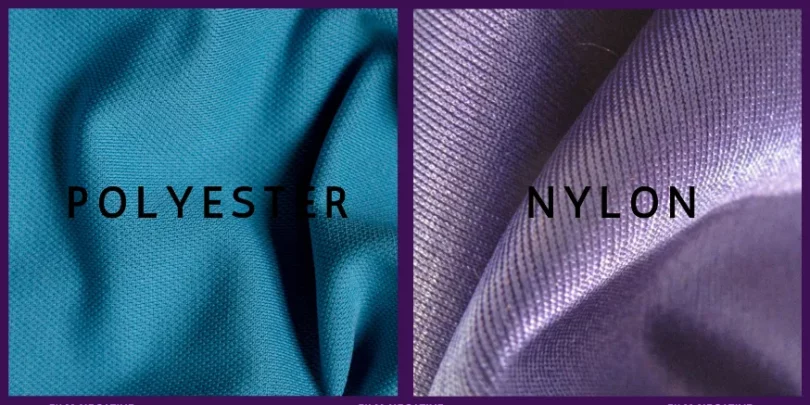Silk is a natural fabric with a luxurious feel, while nylon is a synthetic material known for its durability. When choosing between silk and nylon, consider the desired texture and durability of the fabric.
Silk offers a soft and smooth texture, making it comfortable to wear, but it may be more delicate and prone to damage. On the other hand, nylon is a strong and resilient material that can withstand wear and tear, making it ideal for items that require durability.
Both fabrics have their own unique characteristics, so the choice ultimately depends on personal preference and the intended use of the fabric.

Credit: blog.treasurie.com
Table of Contents
Properties Of Silk
Silk is a luxurious and versatile fabric that has been prized for centuries. Its unique properties make it a popular choice for clothing, bedding, and other textile products. In this section, we will explore the key properties of silk that set it apart from other fabrics.
Softness And Comfort
Silk is renowned for its incredible softness and luxurious feel against the skin. The natural protein fibers of silk create a smooth texture that glides effortlessly over the body, providing unparalleled comfort. This makes silk an excellent choice for those with sensitive skin or allergies, as it is less likely to cause irritation compared to synthetic fabrics like nylon.
Strength And Durability
Despite its delicate appearance, silk is surprisingly strong and durable. The individual silk fibers are known for their exceptional tensile strength, which allows the fabric to withstand stretching and pulling without losing its shape. This durability ensures that silk garments and products can withstand frequent use and washing, making them a long-lasting investment.
Breathability And Hydration
Silk is a highly breathable fabric that allows air to circulate freely, keeping the body cool in warm weather and reducing the risk of overheating. Its natural moisture-wicking properties help to regulate body temperature by absorbing and releasing moisture, keeping you dry and comfortable throughout the day. This breathability also extends to bedding made from silk, promoting a more comfortable and restful sleep.
Additionally, silk has the remarkable ability to retain moisture, helping to keep the skin hydrated and prevent excessive moisture loss. This makes it an ideal fabric for skincare, as it helps to maintain the skin’s natural moisture balance.
Properties Of Nylon
Nylon is a synthetic fiber known for its exceptional properties, making it a popular choice in various industries. From clothing to industrial applications, nylon offers a range of benefits that set it apart from other materials. In this section, we will explore the key properties of nylon, including its strength and durability, stretchability and elasticity, as well as its water resistance and quick drying capabilities.
Strength And Durability
Nylon is renowned for its impressive strength and durability, making it a highly reliable material in numerous applications. With its sturdy composition, nylon can withstand heavy loads and resist wear and tear, ensuring long-lasting performance. Whether it’s used in sports equipment, automotive components, or even parachute cords, nylon’s strength and durability make it a preferred choice.
Stretchability And Elasticity
One of the remarkable properties of nylon is its stretchability and elasticity. Unlike other materials that may break or lose shape when stretched, nylon has the ability to stretch without compromising its integrity. This makes nylon ideal for applications that require flexibility and resilience, such as in clothing, hosiery, and even bungee cords. Its stretchability ensures a comfortable fit while maintaining its original shape.
Water Resistance And Quick Drying
Another notable property of nylon is its water resistance and quick drying capabilities. Nylon fibers have low moisture absorption, making them resistant to water-based damage. Whether it’s rain, spills, or sweat, nylon repels water, keeping the material dry and unaffected. Additionally, nylon’s quick drying nature allows it to dry rapidly, reducing the risk of mold or mildew formation. These properties make nylon an excellent choice for outdoor gear, swimwear, and athletic apparel.
Environmental Impact
Silk and nylon are both popular fabrics used in clothing production, but they have different environmental impacts. Silk is a natural fiber that biodegrades quickly, while nylon is a synthetic material that takes hundreds of years to break down. When considering the environmental impact of your clothing choices, silk may be the more sustainable option.
When it comes to choosing between silk and nylon, it’s not just about the feel or look of the fabric, but also about the environmental impact of the production process and waste management. Let’s explore the environmental impact of both silk and nylon under the following H3 headings:Production Process And Waste
Silk is a natural fiber that is made from the cocoons of silkworms. The production process involves boiling the cocoons to extract the silk fibers, which requires a lot of energy and water. Additionally, the waste produced during the process, such as the pupae and leftover cocoon material, can be used as animal feed or fertilizer. Therefore, the production process of silk has a relatively low environmental impact. On the other hand, nylon is a synthetic fiber made from petrochemicals, which requires a lot of energy to produce. The production process also generates a significant amount of greenhouse gases and toxic pollutants. Moreover, nylon production generates a large amount of waste that takes hundreds of years to decompose, such as microplastics that pollute the oceans and harm marine life.Biodegradability And Recyclability
Silk is a biodegradable material that can decompose naturally without causing harm to the environment. It can also be recycled and repurposed into new products such as clothing, household items, and even surgical sutures. Therefore, silk has a low environmental impact in terms of biodegradability and recyclability. On the other hand, nylon is not biodegradable and can take hundreds of years to decompose. However, it can be recycled into new products such as carpets, clothing, and even car parts. Although recycling nylon can reduce waste, it still requires a lot of energy to recycle and can generate greenhouse gases and toxic pollutants. In conclusion, silk has a lower environmental impact than nylon in terms of production process, waste management, biodegradability, and recyclability. Therefore, choosing silk over nylon can be a more sustainable option for our planet.Fashion And Style
Fashion and style are constantly evolving, and the choice of materials plays a crucial role in defining the overall aesthetic and appeal of clothing and accessories. When it comes to silk and nylon, both materials have unique characteristics that contribute to the fashion industry in different ways.
Uses In Clothing And Accessories
- Luxurious appeal: Silk is renowned for its luxurious texture and lustrous appearance, making it a popular choice for elegant evening gowns, formal blouses, and high-end accessories.
- Breathability and comfort: Its natural properties allow for breathability, making it suitable for various clothing items, including lightweight scarves, lingerie, and flowy tops.
- Versatility: Silk’s versatility extends to accessories such as ties, pocket squares, and hair accessories, adding a touch of sophistication to any ensemble.
- Durability and resilience: Nylon is known for its strength and resilience, making it a popular choice for activewear, hosiery, and sturdy bags and backpacks.
- Versatile applications: Its ability to blend with other materials makes it suitable for a wide range of clothing, including tights, raincoats, and windbreakers, providing functionality and style.
- Affordable alternative: Nylon’s cost-effectiveness has led to its widespread use in affordable fashion items, including everyday clothing and accessories.
Trends And Preferences
The fashion landscape often reflects changing trends and consumer preferences, influencing the prominence of silk and nylon in clothing and accessories.
- Timeless elegance: Despite evolving trends, silk continues to be favored for its timeless elegance, particularly in formal and evening wear, showcasing a preference for sophistication and luxury.
- Sustainable and ethical choices: With an increasing focus on sustainability, there is a growing preference for ethically sourced silk, aligning with conscious consumerism and eco-friendly fashion practices.
- Athleisure dominance: The rise of athleisure wear has propelled the demand for nylon-based activewear, reflecting a preference for functional, performance-driven clothing suitable for an active lifestyle.
- Innovative applications: Nylon’s adaptability has led to innovative applications in contemporary fashion, with designers incorporating the material into avant-garde designs, showcasing its modern appeal.
Cost And Affordability
Silk and nylon are both popular choices for fabric, each offering its own unique benefits. When considering the cost and affordability of these materials, several factors come into play. Understanding the factors affecting the price and the value for money of silk and nylon can help you make an informed decision when choosing between the two.
Factors Affecting Price
The price of silk and nylon is influenced by various factors, including the quality of the material, production methods, and market demand. Quality plays a significant role, with higher-quality silk and nylon typically commanding higher prices. Additionally, production methods such as organic or sustainable practices can also impact the cost. Market demand for certain types of silk or nylon can cause fluctuations in prices.
Value For Money
When considering the value for money of silk and nylon, it’s important to weigh the durability and longevity of the materials against their initial cost. While silk may be more expensive upfront, its luxurious feel and durability can provide long-term value. On the other hand, nylon’s affordability and resistance to wear and tear may make it a cost-effective choice for certain applications.

Credit: www.reddit.com

Credit: www.leatherjacketblack.com
Frequently Asked Questions
Is Nylon Better Than Silk?
Nylon is more durable than silk due to its synthetic properties, making it suitable for everyday use. However, silk is softer and has a luxurious feel, making it ideal for special occasions. Ultimately, the choice depends on personal preference and the intended use.
Why Did Nylon Replace Silk?
Nylon replaced silk due to its durability, affordability, and versatility in various applications. It offered a more practical alternative to silk without compromising on quality or appearance. Nylon’s synthetic nature also made it less vulnerable to insects, moisture, and other environmental factors.
What Material Is Better Than Silk?
Cotton, linen, and wool are some materials that are considered better than silk in terms of durability, affordability, and ease of care. They are also more sustainable and eco-friendly options compared to silk.
Is Nylon Also Called Silk?
No, nylon is not called silk. Nylon is a synthetic polymer, while silk is a natural protein fiber.
Conclusion
Silk and nylon are two of the most popular fabrics in the fashion industry. Both have their unique qualities and benefits. Silk is a luxurious and delicate fabric, while nylon is durable and versatile. Depending on your needs, either silk or nylon can be the perfect choice.
Ultimately, it comes down to personal preference and what you are looking for in terms of comfort, style, and durability. So, choose wisely and enjoy the beauty of your chosen fabric!
